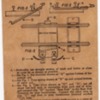Disconnected all the 690 clips for Track 3. Track 1 and 2 work perfectly.
Connected each of the five 690 clips on Track 3 one at a time individually and had the same problem with each one individually and all together.
Disconnected all the 690 clips for Track 2. Track 1 and 3 work perfectly.
Any ideas? I'm fresh out.
Well, I think meter testing for continuity is the way to go.
I have only just recently handled a 690, but I don't think they could fail to short, based on how they are constructed.
Therefore, with the 690's removed for track 3, I believe that you will find continuity between the rails due to a rail insulator failing.
In AF wiring all of the outside rails are tied to common or the base post. Same for the Z-4000. All of the black are tied together.
So, short an inside rail to a sleeper/tie and current can flow. Why it flows to Z4K #2, I can't say.
But, what's important is that a path exists somewhere in the track.
I believe if you test TR#3 rails for continuity, it will be there. Finding where it is could be time consuming.
Another practice that I've adopted is to tin the ends on the wires to a lock-on and put at least one in from the inside, placing wire insulation between the posts to prevent a connection. I bend the end to a 90° with needle nose pliers at the insulation for a good fit.






